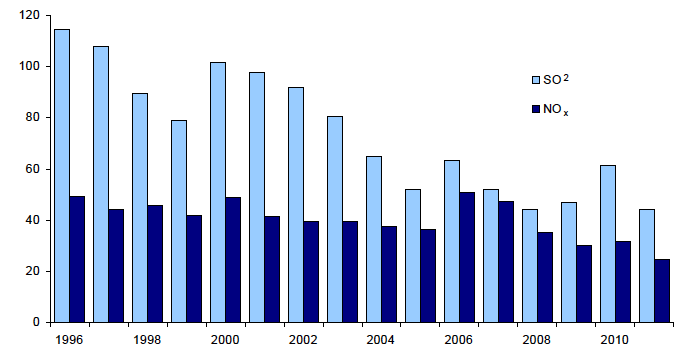Key Scottish Environment Statistics 2012
This publication aims to provide an easily accessible reference document which offers information on a wide range of environmental topics. It covers key datasets on the state of the environment in Scotland, with an emphasis on the trends over time wherever possible.
This document is part of a collection
Emissions of Sulphur Dioxide and Nitrogen Oxides from Large Combustion Plants[11]: 1996-2011
Annual LCP emissions (thousand tonnes)

Sulphur dioxide (SO2) and oxides of nitrogen (NOx) affect human health through respiratory damage, and ecosystem health through acidification. SO2 and NOx are released into the atmosphere through the combustion of fossil fuels. In 2009, large combustion plants (LCPs) accounted for 75% of the SO2 emissions and 33% of NOx emissions in Scotland.[4]
The Large Combustion Plants Directive (LCPD, since revised by 2001/80/ EC) called for a 60% reduction in SO2 emissions by 2003 and a 30% reduction in NOx emissions by 1998, from a 1980 baseline. In 2003, UK emissions of SO2 were 79% below 1980 levels, and 95% below 1980 levels in 2009. In 1998, UK emissions of NOx were 60% below 1980 levels, and 74% below 1980 levels in 2009.[12]
In Scotland, SO2 emissions from the electricity supply industry fell between 1996 and 1999, but there were rises in 2000, 2006, 2009 and 2010. These rises were due to the cold weather and increased use of coal-fired power stations, necessary to offset the reduced capacity of the nuclear sector because of refurbishment work at certain plants. This was followed by decreases in 2007, 2008 and in the most recent 2011 data. In 2011 4 plants no longer complied with the LCPD reporting requirements and were removed from reporting obligations. There was also a decrease in SO2 levels at Longannet power station due to a reduction in the sulphur content of the coal[13] burned in 2011. This combined to show a 28% decrease in SO2 between 2010 and 2011.
Despite increased production of electricity, emissions of NOx emissions decreased by 41% between 2006 and 2009, as new abatement technology helped to reduce the emissions of NOx. This was followed by a small increase of 5% in 2010, before a 22% reduction between 2010 and 2011, in part due to a reduction in Cockenzie's emissions.
Contact
Email: Sandy McPhee
There is a problem
Thanks for your feedback